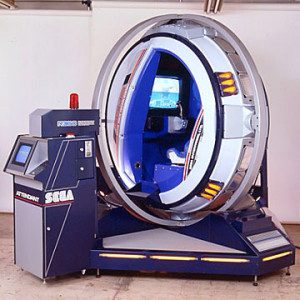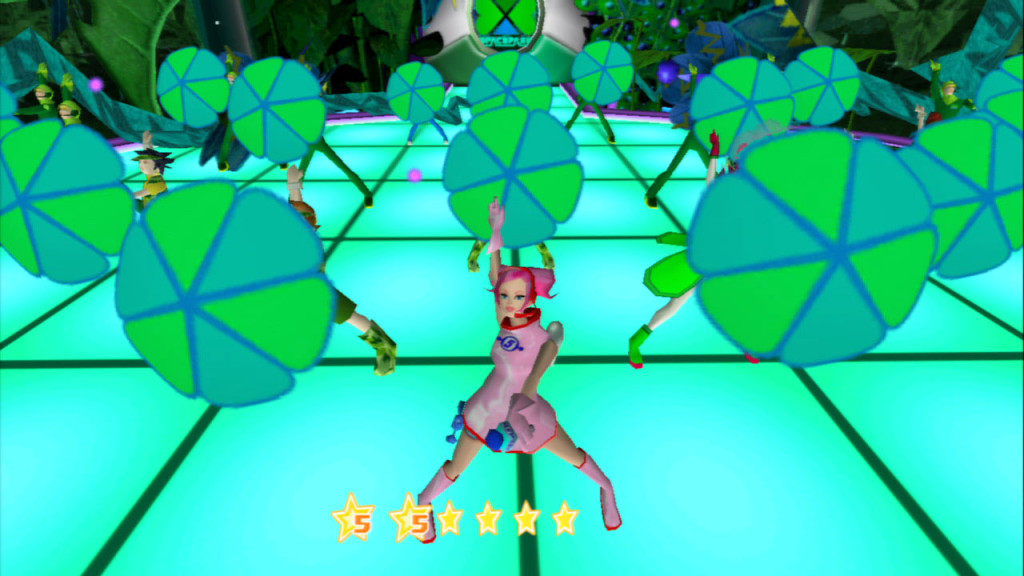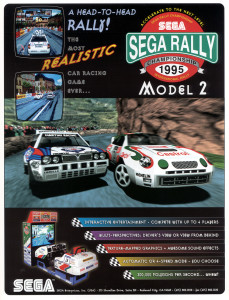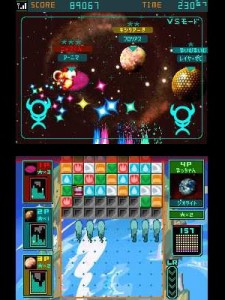Tetsuya Mizuguchi was, at one point, known as a wunderkind for making great arcade racing games (and later Saturn ports of said racing games) before transitioning into a developer at the forefront of the intersection between music and games with titles like Space Channel 5, Lumines, and Rez. These days, he’s got a new company – Enhance Games – and is currently working on Rez Infinite, a re-imagining of perhaps his most beloved title for the PlayStation VR platform.
I had the opportunity to sit down with Mizuguchi at this year’s Game Developers Conference, not long after he gave his postmortem presentation on the production of Rez. Without further ado, let’s chat with Tetsuya Mizuguchi!
During your presentation this morning, one of the games you brought up as an inspiration was Xevious. I find that very interesting, as I don’t think the impact Xevious had on the game industry is particularly well known outside of Japan. Can you tell us a bit more about what this game means to you?
- I was in high school around the time Xevious released. When school got out, you could go to one of two places: Game centers1 or cafes. It wasn’t uncommon for these cafes to have a few arcade machines – though not as many as a full-on game center would. We’d stop by after school – or maybe we’d even ditch class – to have some drinks and play games. When we played Xevious, it was a very fresh, brand-new experience – the sounds, the bright colors, it was just so refreshing to play regularly.
You also mentioned an Amiga game, Xenon 2, as a major influence. I was quite surprised by this, as I didn’t think the Amiga was popular at all in Japan.
- You’re right. Japan’s PC market at the time was dominated by NEC’s PC-98. You had to be a very high level of geek in order to even know about the Amiga. One of my really good friends was the hardcore “mania” guy out of our little nerd group, and he’d have a whole bunch of these amazing demos from Europe.When Xenon 2 booted up and I saw all of those logos, it got me thinking – musical artists in games, is that a thing? I didn’t know that something like that existed. I was immediately hooked. The game felt like a real diamond in the rough and captivated me immediately.
Actually, after the presentation, Eric Matthews [who was part of the Bitmap Brothers] came up and introduced himself. It was an incredibly cool moment!
So how did you wind up joining Sega?
- I went to the arcades a lot, obviously, and one day I came across this machine by Sega, the R-360.
 I was utterly amazed by this machine, and when I looked at the cabinet, I saw the brand name Sega on it. So, essentially what I did was – I walked my way to their headquarters in Ootori and spoke to the receptionist. I told them, “I want to work at Sega.” The receptionist turned me away and told me I had to go through the proper channels. “There’s a thing called a resume, and you have to have an interview…”
I was utterly amazed by this machine, and when I looked at the cabinet, I saw the brand name Sega on it. So, essentially what I did was – I walked my way to their headquarters in Ootori and spoke to the receptionist. I told them, “I want to work at Sega.” The receptionist turned me away and told me I had to go through the proper channels. “There’s a thing called a resume, and you have to have an interview…”
*Laughs*
- So I went back home, did my research, and found that there was a proper channel to apply. So I did that, and I actually did get an interview. The impression I got from them was “You know what? This guy’s crazy, but we may well need someone like him, and he just might fit into our team.” So that’s how I got my job at Sega. I didn’t go anywhere else. I only went to Sega! They were just so cool!
I guess that kind of fits into the later experience you’d have of working on Sega Rally with its huge, car-shaped cabinet. How did development on that game play out?
- There were about 10, 12 people on the team, all around 26 or 27 years old… I was 27. So all youngsters, no experience making games… especially car games! But we had a real passion, and we wanted to make a rally racing game. 3D technology, like the texture-mapping of the Model 2, was really new at the time. All of the racing games that were out at the time were about racing on asphalt courses. I wanted to use the graphic power to create varied landscapes, like sand and rocks, and have logos on the cars – Sega Rally was actually the first 3D racing game to have real sponsors and cars. I have a lot of stories about those!
An element people really remember from Sega Rally is the soundtrack by Takenobu Mitsuyoshi. Seeing as you’re someone who is very interested in the intersection between music and gaming, what was it like to have worked with him?
- Again, it’s all about passion. He put 1000% passion into that music! I actually didn’t give him a lot of direction – it was almost all him. You have to think about rally as a sport – there’s a wide range of terrain and racing skills involved. When you’re in a rally, you have to go for it – you can’t hesitate. There’s a lot of passion in drifting, steering, and controlling; You have to put your heart into it. That has to be conveyed through the music. He did a fantastic job translating that passion into songs.
Your early games at Sega were mostly racing titles. How did you convince them to let you try making your other game ideas, like Space Channel 5 and Rez?
- There are a lot of restrictions you have to take into account when making arcade games. It has to be a short-but-sweet experience lasting a few minutes, and there’s not a major story/narrative component you can inject into it within that short amount of time. But I definitely learned a lot from making arcade games, especially when they were exposed to audiences outside of Japan. Those learning experiences were applied and stacked on top of what I always wanted to do, which was make games outside of the arcade with more narrative and character progression. I then pitched those ideas to the higher-ups at Sega, and that’s how Space Channel 5 happened.
When I think about the games we had at that time, whether they were arcade games or home games, they all fit into neat little compartmentalized genres. But there was a different sort of expression I was searching for. How do I make the player happy? How do I make the people around the player happy, too? With Space Channel 5, I was going in that direction. I wanted the challenge myself and see how many people we could make happy all at one time.
With Rez, it was more about conveying the joy of listening to music through a game. The two titles share a common denominator in that they’re based around music, but they have a very different sort of expression. One aims to make you happy; to make you want to get up and dance, while the other aims to create a deeper response to the creation of music itself.
I’m curious about your thoughts regarding the current crop of music-driven arcade games in Japan. There’s a lot of new titles that make use of interesting control mechanisms, where you use your body and motion.
- To be honest, I haven’t really been to game centers lately… *laughs* But from what you’ve described, it tells me something important: that people are looking for that type of experience. I may not be making a game for that particular market, but it shows that there’s a hunger among consumers for new experiences.
I played Rez Infinite in VR earlier today, and it felt like a very natural fit. Are you having any issues adapting the game for the new platform?
- I also believe that Rez was really made for VR. There’s been a lot of fine-tuning to make sure it feels as natural as possible in VR. Our developer, Monstars, are very meticulous and detail-oriented. They’ve been working really hard to make sure the VR experience of Rez comes alive in the best possible way.
One thing I’ve been wondering is what the rights situation with Rez is. Can you elaborate?
- Sega are still the owners of the Rez IP. We’re licensing it from them.
Does Sega still hold the source code as well?
- The original source code is at Sega, but when I went to Q? Entertainment, we did the HD version for XBLA. It remained at Q?, so I bought the source code from them to use as a base for Rez Infinite.
Could you see yourself going back to other Q? games, like Child of Eden, and redoing them in a VR format?
- It’d be nice to do a VR version of Child of Eden, for sure. However, the publishing rights for that particular title are tied up with Ubisoft.
You formed Enhance Games since Q? was shifting to mobile development. I feel like the attitude in the West is that Japanese developers “sell out” by shifting to mobile games. What are your thoughts on this?
- I feel as though the shift has been too extreme – almost everyone’s shifting to mobile.. There’s little diversity in the current marketplace. They’re putting all of their eggs in one basket, and I don’t see it as healthy for designers and creators. For Enhance Games, I intentionally wanted the firm to be based stateside.
While the “brains” of Enhance Games are in Japan, it’s technically an American company. But we don’t care about that! It’s about banytime, anywhere we can communicate, create, design… games are a global form of entertainment.
You think that developers are putting all their eggs in one basket with mobile, but do you worry that Enhance Games might also be doing the same with VR?
- We haven’t really done anything drastic like drawing a line in the sand any saying, “We’re not doing anything that isn’t VR.” I’m not putting any restrictions on projects or ideas. It’s all in the name, “Enhance.” Whatever the platform, I’m looking for the opportunity or idea that would enhance the gaming experience.
Okay, one last, personal question – one of my favorite games that you’ve worked on is Meteos, which you collaborated on with Masahiro Sakurai. Much like you, he talks a lot about game design and player experience. What are your impressions of him, and would you want to work with him again?
- Simply put: Sakurai is a design genius. If there was a global game design competition, Sakurai would be at the top. He really knows how to put all of the components of a game together in an amazing way. It would truly be great if I had the opportunity to work with him again.
- The Japanese term for an arcade ↩



One Comment